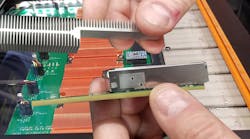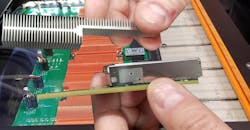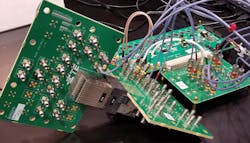The IEEE’s 400 Gigabit Ethernet standardization process was completed and published in December 2017 by the IEEE 802.3bs Ethernet Working Group. Connector and test vendors are working to deliver the necessary hardware to make it a reality, and have it ultimately become a high-demand technology in the cloud and the enterprise.
The 8-lane, Quad Small Form-factor Pluggable Double Density (QSFP-DD) form factor is one of four connectors that will target 400G Ethernet connections (Fig. 1). The others include OSFP, CFP8, and COBO. These new form factors are needed to handle the 25-Gb/s NRZ, 56-Gb/s PAM-4, or potentially 112-Gb/s PAM-4 signaling needed for 400G and beyond.
1. The QSFP-DD form factor will likely use 25-Gb/s NRZ, 56-Gb/s PAM-4, or potentially 112-Gbit/s PAM-4 signaling.
The QSFP-DD specification defines power classes up to 14 W, which can be a challenge when building high-density switches. OSFP adds an integrated heat sink, allowing it to handle 15 W. QSFP-DD is backwards-compatible with QSFP, while OSFP is not.
Vendors like Amphenol, Molex, TE Connectivity, and Yamaichi were showing microQSFP and QSFP-DD solutions at this year’s DesignCon conference in Santa Clara, Calif. Much of the discussion was around the need to keep the systems cool. TE Connectivity’s demonstrations highlighted side-to-side airflow for microQSFP based 100G and 200G switches and front-to-back airflow for QSFP-DD 400G switches (Fig. 2).
2. One of TE Connectivity’s DesignCon demonstrations highlighted side-to-side airflow for 100G and 200G switches using the microQSFP form factor.
QSFP-DD doubles the number of lanes, but provides four times the throughput of QSFP by also increasing the signaling rate. The QSFP-DD MSA defines this pluggable form factor, including a mechanical module that’s a 2x1 Cage with connector, thermal, pinout and management specifications.
Molex was showing the Impulse Direct Backplane connector system designed to handle 56G and 112G PAM-4 signals. The connectors are designed for high-density applications. The system uses a hermaphroditic signal beam design that improves insertion loss while lowering mating force. It has a 2-mm column-to-column pitch. Assemblies are available with 96 (6- by 16-pair) and 128 differential pairs. The U-shaped ground blades provide mechanical isolation between pins, while the connectors use Impel backplane connector guides.
TE Connectivity's STRADA Whisper (Fig. 3) connector system is also designed to handle high speed serial connections. It can handle orthogonal and cabled backplane connections. The connector minimizes connector and footprint crosstalk using the latest eye-of-needle (EON) technology, enabling successful operation at 112G PAM-4 operation.
3. TE Connectivity's STRADA Whisper connector system designed to handle 56G NRZ and PAM-4 signals.





